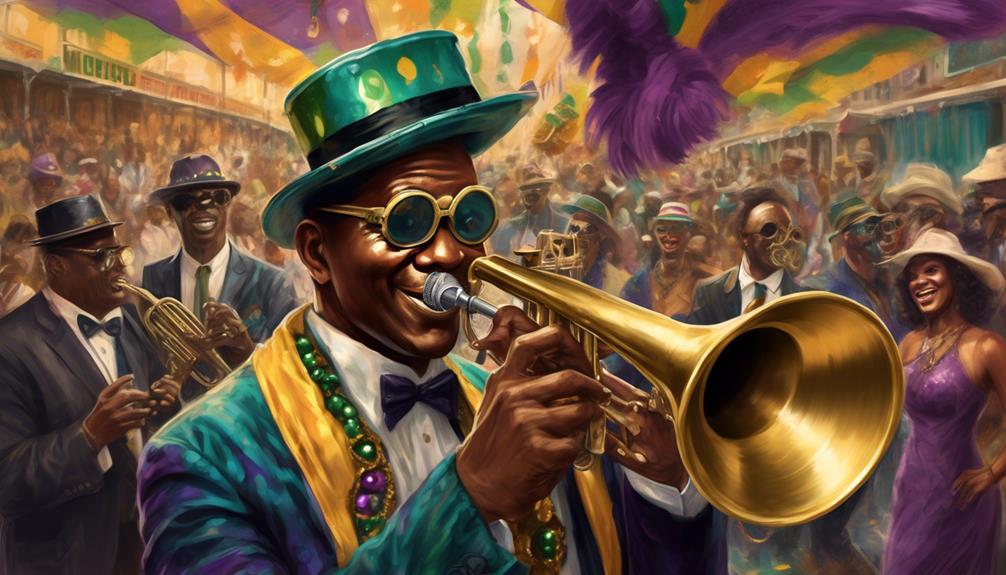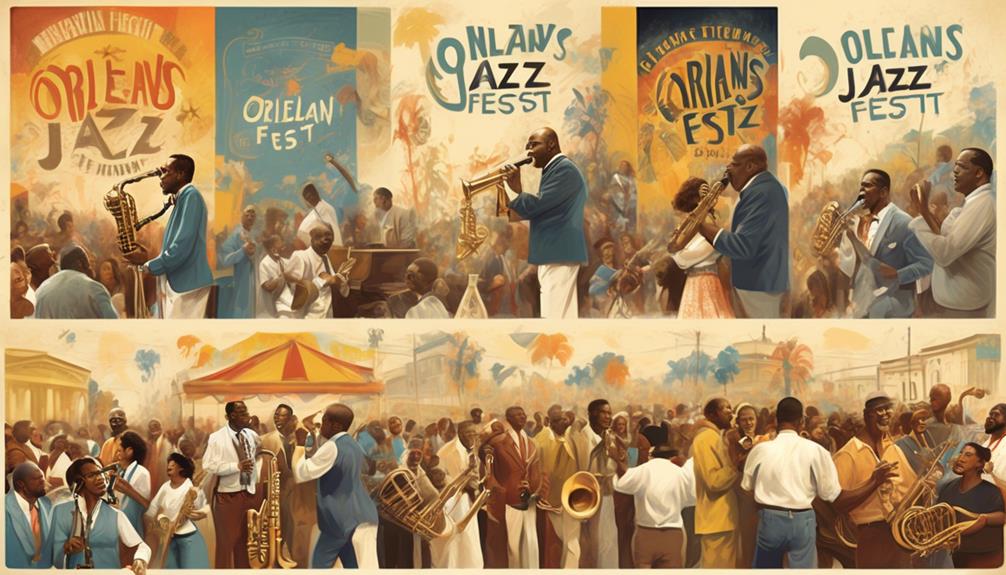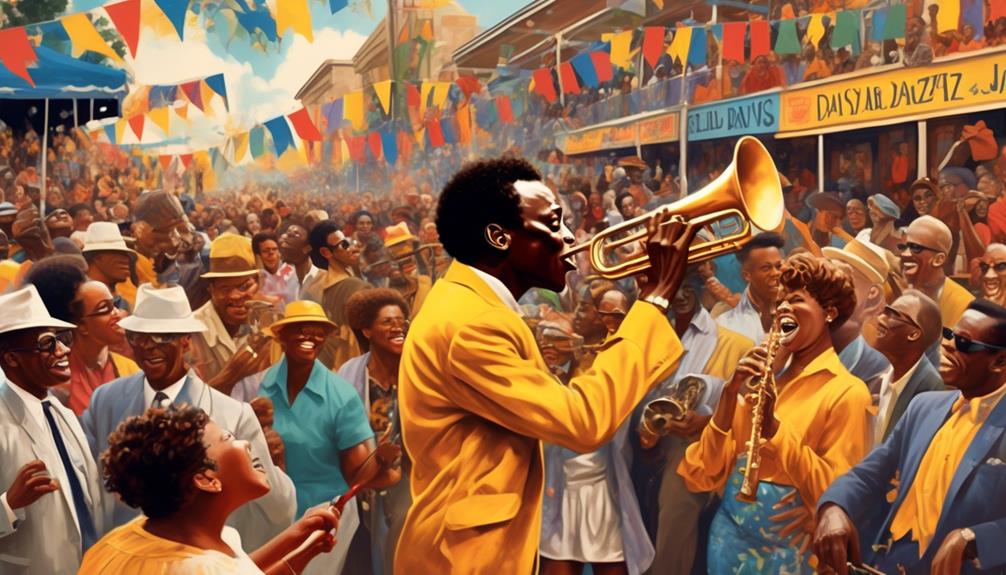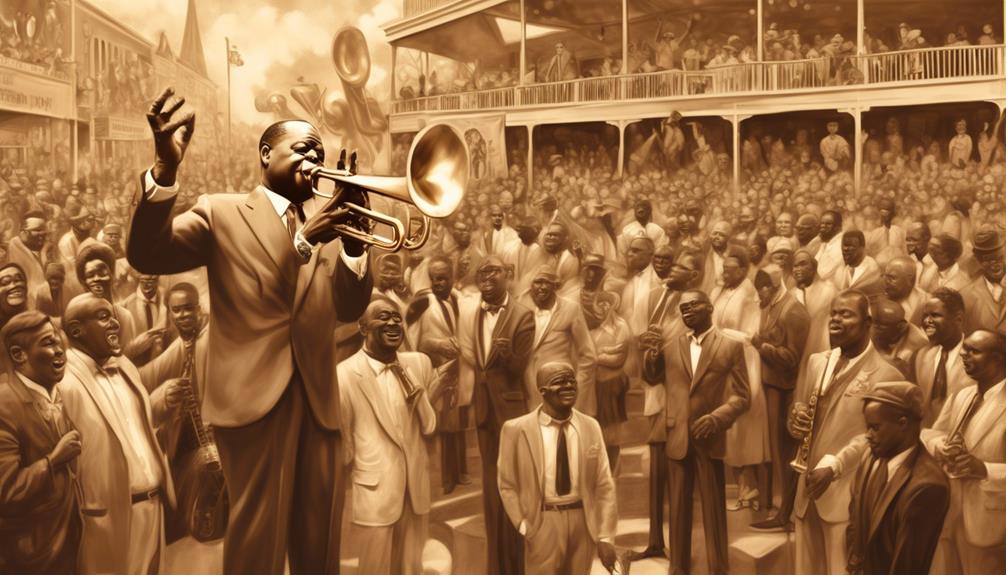
Imagine the vibrant hues of the sunset painting the New Orleans sky, the electrifying beats of jazz music filling the air, and the excited chatter of thousands of festival-goers. You're stepping into the iconic Orleans Jazz Fest, a melting pot of culture, music, and celebration.
Over its rich history, four key moments have shaped this festival into the international sensation it is today. From its humble beginnings in 1970 to its triumphant return post-Hurricane Katrina, each moment tells a story of resilience, passion, and the undeniable spirit of New Orleans.
Intrigued? Let's unpack these monumental instances that have left indelible marks on the canvas of this grand fest.
Key Takeaways
- The first festival held in 1970 marked the inception of the New Orleans Jazz & Heritage Festival and showcased the vision of George Wein and the organizers.
- The historic 1970 festival celebrated cultural diversity and featured memorable performances by Mahalia Jackson and Duke Ellington, highlighting the spirit of New Orleans.
- The iconic performances in 1990, including Stevie Wonder, Gladys Knight & the Pips, and Fats Domino, marked a turning point in the festival's expansion and showcased homegrown talents as well.
- The post-Katrina 2006 Renaissance of the festival became a symbol of hope and rebirth for New Orleans, featuring performances by Bruce Springsteen, Pearl Jam, and Harry Connick and highlighting the city's resilience and local flavor.
The Inception of Orleans Jazz Fest

Imagine stepping back to April 1970, when the first Orleans Jazz Fest was held, featuring performances from the likes of Mahalia Jackson and Duke Ellington. This was a time when the New Orleans Jazz and Heritage Festival presented its inaugural event. Envisioned by George Wein as a culturally significant occasion, this Festival was born out of years of discussions and efforts by city leaders.
The first of the New Orleans Jazz Fests was overseen by the newly established New Orleans Jazz & Heritage Foundation. The event was a humble one, attracting only around 350 attendees. But don't let this modest beginning fool you. This was merely the prelude to what was to become a beloved and world-renowned tradition.
The Historic 1970 Festival
You'd have been one of the lucky 350 attendees at the historic 1970 Festival, marking the birth of the first New Orleans Jazz & Heritage Festival. This event was produced by Quint Davis and Festival Productions, and was held at the Fair Grounds Race Course. It featured legendary artists like Mahalia Jackson and Duke Ellington. City leaders who wanted to create an event worthy of the city's rich heritage orchestrated it.
This historic festival was the result of:
- The vision of city leaders who wanted to celebrate the city's cultural diversity.
- The tireless work of producer Quint Davis and the New Orleans Jazz & Heritage Foundation.
- The spirit of Mahalia Jackson, who brought the Eureka Brass Band back for an unforgettable performance.
The Heritage Festival was envisioned as a celebration of the city's unique culture and history. Its success paved the way for the growth and recognition of the New Orleans Jazz and Heritage Festival in the years to come. The 1970 festival not only marked a key moment in Orleans Jazz Fest history but also set a benchmark for cultural events worldwide.
The Iconic 1990 Performances

The 1990 Jazz Fest turned up the heat with iconic performances by stars like Stevie Wonder, Gladys Knight & the Pips, and Fats Domino, marking a significant chapter in the festival's timeline. These 1990 performances are forever etched in the Orleans Jazz Fest history as a key moment. Imagine being among the crowd, soaking up the New Orleans atmosphere as these legends graced the stage.
As the Jazz and Heritage Festival expanded in the '90s, the International Pavilion and Native American stage were added, enhancing the global appeal. This growth was reflected in the total attendance, which skyrocketed, surpassing an impressive 650,000 in 2001.
But it wasn't just about the international stars. Homegrown talents like Pete Fountain and Al Hirt also shone brightly. Their performances, too, became iconic, cementing the 1990 Jazz Fest as a pivotal point in history.
In 2004, AEG Live joined forces with Jazz Fest, another key moment in the festival's history. Every year, the festival takes place, it's a chance to relive the magic of these iconic performances, a testament to the rich heritage and vibrant culture of New Orleans.
The Post-Katrina 2006 Renaissance
Undeniably, the 2006 Jazz Fest marked a significant post-Katrina renaissance, transforming into a homecoming and celebration of the city's vibrant culture. In the wake of Hurricane Katrina, the Crescent City faced a daunting challenge, but the Jazz Fest served as a beacon of resilience, a testament to New Orleans' enduring spirit.
- The 2006 Jazz Fest became a symbol of hope and rebirth. Shell Oil's crucial support as a presenting sponsor ensured the festival's presentation, marking a turning point in the recovery of the Orleans Jazz and Heritage.
- The Acura Stage hosted memorable performances by Bruce Springsteen and Pearl Jam. These electrifying sets stirred the crowds, echoing the city's heartbeat and echoing the resilience of its people.
- Finally, New Orleans' own Harry Connick took the stage, reminding everyone that the essence of the Jazz Fest, like the city itself, lay in its unique local flavor.
This chapter in the four key moments in Orleans Jazz Fest history illustrates the city's ability to bounce back and celebrate its cultural heritage, much like the legendary Newport Jazz Festival. The post-Katrina 2006 renaissance wasn't just about music; it was about a city reclaiming its spirit and its pride.
Memorable 2011's Tribute to Louis Armstrong

Imagine yourself at the 2011 Jazz Fest, witnessing a historic tribute to Louis Armstrong that featured iconic performances by jazz luminaries like Wynton Marsalis, Kermit Ruffins, and Dr. John. The air in New Orleans was electric as the city's jazz community came together to honor the legacy of a man whose music had defined a genre and a city for over 151 years.
The tribute, an unforgettable moment in the festival's history, celebrated Armstrong's influence on jazz, a genre he helped shape and define. You'd have felt the spirit of Louisiana, the heart of jazz music, pulsing through every note played. Each performance, a testament to Armstrong's enduring place in the city's musical landscape.
The city of New Orleans, the birthplace of jazz, and the Jazz Festival, a celebration of this rich heritage, came alive during 2011's tribute to Louis Armstrong. It was a moment that showcased not just the past, but the ongoing vibrancy and relevance of jazz in the city's cultural identity. The 2011 Fest, with its memorable tribute, was a reminder of how deeply jazz is woven into the fabric of New Orleans.
The 50th Anniversary Celebration in 2019
Fast forward to 2019, and you're at the 50th Anniversary Celebration, surrounded by a diverse mix of big names like Widespread Panic, Katy Perry, Dave Matthews Band, and Chris Stapleton, marking a significant milestone in the festival's rich history.
Over the years, Jazz Fest has received global recognition, and rightly so. New Orleans wouldn't be the same without it. The spirit of Jazz Fest is deeply ingrained in the culture of Louisiana.
The festivals were held annually, and for the 50th anniversary celebration in 2019, Jazz Fest expanded to two full weeks, exemplifying its growth since the first Jazz Fest.
The 2019 celebration was special:
- Despite the cancellations of the Rolling Stones and Fleetwood Mac, the festival showcased local favorites and New Orleans artists, keeping the spirit alive.
- The celebration culminated with a performance by Widespread Panic, cementing the festival's half-century of musical and cultural significance.
- The 50th Anniversary served as a testament to the festival's enduring legacy as a cultural force and symbol of authenticity.
The 50th anniversary was a perfect celebration of how far Jazz Fest has come and its inseparable bond with the city of New Orleans.
Frequently Asked Questions
What Is the History of Jazz Music in New Orleans?
You're asking about New Orleans jazz history. It's rooted in the city's rich cultural mix, developing from ragtime, blues, and brass bands in the early 20th century, becoming a cornerstone of American music and culture.
What Is the Famous Jazz Festival in New Orleans?
You're right on the money! The famous jazz festival in New Orleans is the Jazz & Heritage Festival. From humble beginnings, it's grown into a musical extravaganza, a testament to the city's vibrant culture.
What Is Unique About New Orleans Jazz?
You'll find New Orleans jazz unique due to its blend of African, Caribbean, and French influences. It's a vibrant, distinct style celebrated at the Jazz Fest, along with a variety of other music genres.
What Year Was the First Jazz Fest in New Orleans?
You're curious about the birth of the New Orleans Jazz Fest, aren't you? Well, the first festival, graced by the likes of Mahalia Jackson and Duke Ellington, kicked off in April 1970. Quite a historic event!
Conclusion
You've journeyed through the Orleans Jazz Fest history, from its humble 1970 beginnings to the triumphant post-Katrina renaissance.
You've felt the rhythm of iconic performances and paid homage to Louis Armstrong.
As you celebrated the 50th anniversary in 2019, you couldn't help but marvel at the festival's resilience, its commitment to culture, and its unwavering spirit.
This is more than music; it's a testament to the indomitable soul of New Orleans – a song that will always play on.
